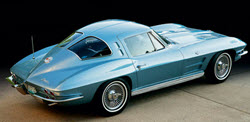1969 Corvette Sting Ray

In November 1969, the 250,000th Corvette was created. Since the new 1968 Corvette Sting Ray had received quite a lot of criticism, Chevrolet worked hard to improve the 1969 Corvette Sting Ray. A strict regime was established to track down, investigate and resolve all sorts of problems. They also included a lot of new features, such as a fibre optics system linked to the centre console that made it possible for the driver to keep an eye on the lights function.
The 1968 model had been criticized for having a small and uncomfortable interior, and the door panels were therefore altered to make the interior room larger in the 1969 Corvette Sting Ray. The diameter of the steering wheel was decreased by one inch, from 16” to 15”. To make the car more difficult to steal, the ignition key was moved from the upper corner of the tachometer to the steering column. Another difference between the 1968 model and the new 1969 Corvette Sting Ray was the side exhaust. Side exhaust pipes had long been one of the signature features of a Corvette Sting Ray, but they were not present the 1968 model. Traditional Corvette enthusiasts all over the world were happy to see their return on the 1969 Corvette Sting Ray. The 1969 Corvette Sting Ray also had back up lights integrated into the tail lights.
In 1969, the 327 cu in engine was dropped and the 350 cu. in. became standard. The price of a new 1969 Base Corvette Convertible with 350 cu. in. 300 hp engine and a three speed manual transmission was $4,438. The coupe variant cost $4,781. If you wanted to boost your 350 cu. in. from 300 hp to 350 hp you paid an extra $132. There were also four 427 cu. in. engine alternatives available.
The two most expensive engine variants, L71 and L88, were racing engines and not really a good choice for street cars. The L88 427 cu. in. 430hp engine cost a whopping $1,032 and was only installed in 0.3 % of the cars. The L71 427 cu. in. 435hp engine for $437 was a more popular alternative, but still only opted for by 7% of the buyers.
For those who wanted a 427 cu. in. engine but planned to driver their cars in the street rather than on the race track, the L36 and L68 engines were better options. The L36 427 cu. in. 390hp engine cost $221 and was installed in over 27 % of all 1969 Corvette Sting Rays. The 400hp alternative was more expensive, $327, and chosen by less than 6 percent of all buyers.
Curiously enough, the 1968 Corvette Sting Ray had no “Sting Ray” name tag on the exterior of the car. In 1969, this had been remedied and the name was proudly displayed on the car – now spelled “Stingray”. Under the Stingray emblem, as well as behind the front wheels, you could get louver trim, an option dropped for the 1970 Corvette Sting Ray. Inside the car, below the shifter, you could find information about horsepower, torque, displacement and compression ratio.



